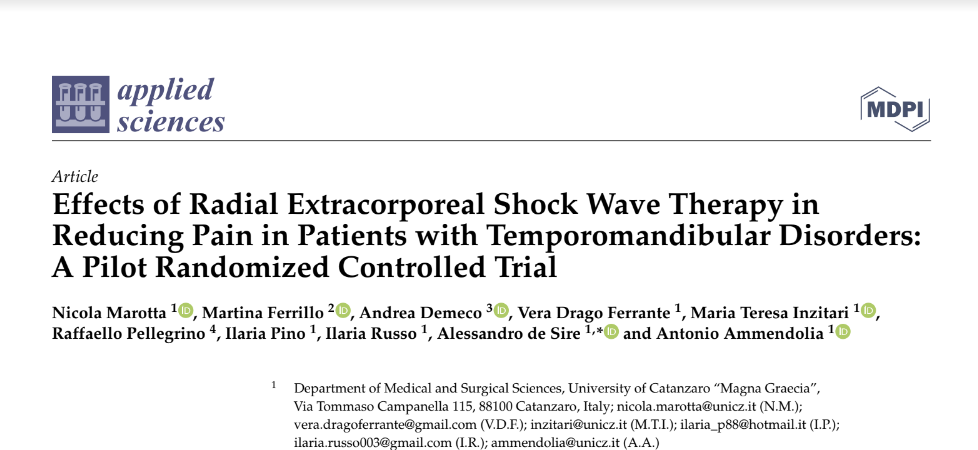A Comprehensive Examination of Radial Shockwave Therapy as a Groundbreaking, Non-Invasive Treatment Option for Temporomandibular Disorders
Are you or a loved one experiencing persistent pain or discomfort in the jaw?
Temporomandibular disorders (TMD) are intricate, often debilitating conditions that affect the muscles and joints connecting the jawbone to the skull. These disorders can significantly impede regular activities such as eating, speaking, and even sleeping. If you are in search of a non-surgical and non-pharmacological treatment avenue, radial extracorporeal shock wave therapy (rESWT) may represent a significant step forward in patient care

Temporomandibular disorders (TMD) encompass a broad range of conditions that impact the muscles and joints of the jaw. These disorders are more common than many realize, with studies suggesting that they may affect approximately 90% of the general population at some point in their lives (Manfredini et al., 2011). Such disorders have the potential to substantially degrade patients’ quality of life. In light of this, it is of the utmost importance to establish effective and accessible treatment strategies. Currently, conservative treatment options for TMD include oral non-steroidal anti-inflammatory drugs, orthodontics, electrotherapy, physical therapy, occlusal splints, oxygen-ozone therapy, and extracorporeal shock wave therapy (ESWT). This article will focus particularly on rESWT, highlighting its promise as a non-invasive treatment modality for TMD, and providing detailed insight into recent research developments.

A Closer Look at the Pilot Study
A recent pilot study conducted by Marotta et al. (2022) aimed to rigorously assess the efficacy of rESWT, when combined with physical therapy, for relieving pain and enhancing muscle activity in patients with TMD. This randomized controlled trial involved 15 adult patients who had been professionally diagnosed with myofascial pain, with or without limitations in mouth opening—a common symptom of severe TMD.
Patients were strategically divided into two groups:
- Group A (treatment group, n=8): Received four sessions of bilateral manual therapy (20 minutes each) and 3 minutes of rESWT therapy (2000 impulses at 1.8 bars energy and 18 Hz frequency, one session per week for 4 weeks).
- Group B (control group, n=7): Underwent the same protocol as Group A, but with sham (placebo) rESWT therapy.
All participants engaged in a meticulously designed 4-week semi-standardized rehabilitative treatment protocol, ensuring consistency in care across both groups.
Key Findings and Implications
The primary outcome measure for this study was pain associated with TMD, evaluated using the Visual Analogue Scale (VAS), a widely respected tool for pain assessment. Secondary outcomes included the activity of the masseter and anterior temporalis muscles, assessed using surface electromyography (sEMG). This technique employs a wireless medical device to detect the electrical activity of masticatory muscles and reports occlusal parameters that represent load distribution on the dental arches.
The results were promising: they indicated a statistically significant reduction in pain intensity in the treatment group compared to the control group. Moreover, the study reported significant improvements in muscle activity and the percentage of the overlapping coefficient (POC) in the active rESWT group. Impressively, there were no recorded dropouts or adverse side effects during the study.
Potential Benefits of rESWT for TMD Patients
- Non-invasive Treatment Option: Unlike surgical interventions, rESWT does not necessitate incisions, minimizing the risk of infection and reducing recovery time.
- Pain Relief: The study demonstrated rESWT’s remarkable effectiveness in reducing pain intensity in TMD patients, offering a significant improvement in patient comfort and quality of life.
- Improved Muscle Functionality: The results indicated that rESWT enhanced muscle performance and relaxation in patients, potentially facilitating improved jaw function.
- Safety and Tolerability: Notably, no adverse events or patient dropouts were reported during this study, indicating that rESWT is likely a safe and well-tolerated treatment choice for TMD patients.
Conclusion
This pilot study illuminates the promising potential of rESWT as a non-invasive, groundbreaking therapeutic option for managing TMD effectively and compassionately. While the results are indeed encouraging, they represent a call for further, more expansive research and larger-scale clinical trials. Such studies are essential to confirm these findings robustly and to investigate the long-term effects and potential contraindications of rESWT in TMD patients. If you are experiencing symptoms of TMD, we strongly recommend consulting with your healthcare provider about the potential of rESWT treatment as part of a comprehensive care plan tailored to your unique needs and circumstances.
Benoy Mathew, MSc, MCSP,
Advanced Practice Physio & MSK Sonographer,
Head of MSK Education, Venn Healthcare
References
Marotta, N., Ferrillo, M., Demeco, A., Drago Ferrante, V., Inzitari, M.T., Pellegrino, R., Pino, I., Russo, I., de Sire, A., & Ammendolia, A. (2022). Effects of radial extracorporeal shock wave therapy in reducing pain in patients with temporomandibular disorders: A pilot randomized controlled trial. Applied Sciences, 12(8), p.3821.




